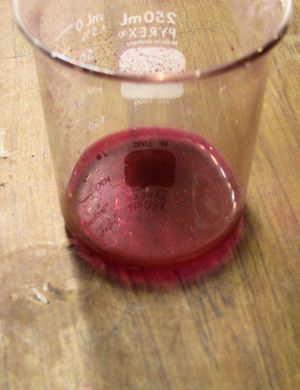Cobalt(II) chloride
Cobalt(II) chloride is a colorful compound with the formula CoCl2. Three hydrates of cobalt chloride exist, anydrous, dihydrate, and hexahydrate. All three hydrates are hygroscopic, with the anhydrous a light blue color, and the di and heptahydrate violet. All three are useful reagents which are commonly used as starting points for reactions involving cobalt.
Contents
Properties
Chemical
In the presence of ammonia or amines, cobalt(II) is readily oxidized by atmospheric oxygen to give a variety of cobalt(III) complexes, such as hexamminecobalt(III) chloride:
- 4 CoCl2•6H2O + 4 NH4Cl + 20 NH3 + O2 → 4 [Co(NH3)6]Cl3 + 26 H2O
CoCl2 will react with sodium hypochlorite, to form cobalt(III) oxide.
Physical
Cobalt(II) chloride is a salt that is blue when anhydrous and pink-purple when hydrated. The compound melts at 735 °C (anhydrous), 100 °C (dihydrate), 86 °C (hexahydrate). It boils at 1049 °C. CoCl2 is soluble in water (52.9 g/100 mL at 20 °C) methanol (38.5 g/100 mL), and slightly soluble in acetone, diethyl ether. The density for the three forms is 3.356 g/cm3 (anhydrous), 2.477 g/cm3 (dihydrate), 1.924 g/cm3 (heptahydrate).
Preparation
Cobalt chloride heptahydrate can be synthesized by reacting two moles of hydrochloric acid with one mole of cobalt carbonate. Add a small amount of acid and then stir the mixture before adding another small portion, as the CO2 created can cause the mixture to overflow. Usually there will be a layer of unreacted cobalt carbonate/other contaminants which must be filter out using either vacuum or gravity filtration if order to receive a pure product.
- CoCO3 + 2 HCl → CoCl2 + CO2+ H2O
By heating this solution to dryness a light blue powder will be formed which is anhydrous cobalt chloride.
If heptahydrate crystals are desired the solution may be dried in a desiccator.
Availability
Cobalt(II) chloride can be purchased from chemical suppliers, both as solid and as solution.
It can also be found in some types of colored silica gel, though the amount is small.
Cobalt(II) chloride, along with other cobalt(II) compounds is classified as "Substance of very high concern" in the EU and its sale is regulated.
Projects
- Cobalt chloride can be used for synthesis of many complexes, such as Hexamminecobalt (III) chloride and Potassium cobaltinitrite.
- Invisible ink
- Electroplating cobalt metal
- Water indicator, especially in desiccants.
Handling
Safety
Cobalt dichloride is a strong allergen, with a LD50 of 80mg/kg (rats).
Eye and hand protection should be worn while handling this compound.
Storage
Cobalt(II) chloride should be stored in an air tight containers or bags to counter its strong hygroscopic nature.
Disposal
Cobalt dichloride should be neutralized before disposal.

